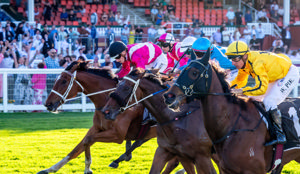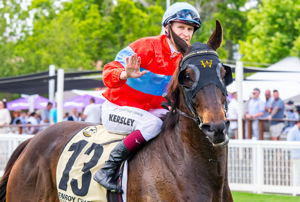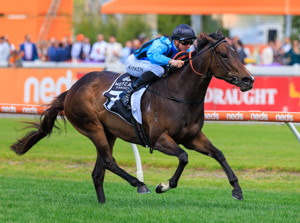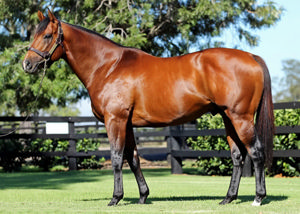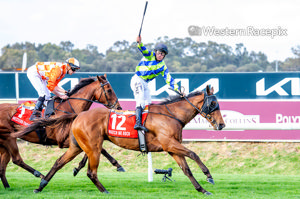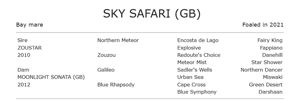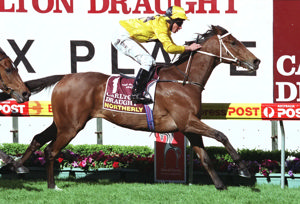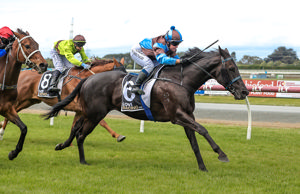Wet Melbourne Cups have a different character, and are often memorable... and we might just see one on Tuesday!
Thankfully, in 2025 we won't be watching anything like the infamous Cup of ‘76, the greatest slogfest of all time!
Flemington had already been drenched by unrelenting rain overnight, but 78,500 hardy revellers and punters rocked up on Cup Day regardless, with clearing skies boosting their mood.
Then - just an hour before The Cup - the skies began to darken alarmingly.

Those who were there that fateful afternoon would never forget the sight of the approaching storm, borne in on an ominous bank of black clouds illuminated by an alien shade of green.
Racegoers were beginning to amass on the famous Flemington lawns to grab their Cup viewpoint.
Everyone had backed one of two combatants.
They were the favourite, Bart’s fine Kiwi-bred stayer Gold And Black, a son of noted mudlark In The Purple - and Van Der Hum (Hermes), another from across the ditch who was known to be at least part-duck.
Now suddenly the air of anticipation turned to panic, and people ran blindly for cover as an enormous and violent downburst hit Flemington.
As the tempest raged, roofs began to sag under the sheer weight of water hammering upon them. The bookies watched on forlornly as the betting ring went under, and the deserted lawns became actual lakes.
Finally it was over. The Cup would run! Doubtful that would be the case in 2025 - but things were different then.
After a long delay, the shell-shocked crowd ventured out to view the runners sloshing around the mounting yard - a mere formality, because everyone knew only two of them had flippers.
Van Der Hum was smashed in betting late. Off he went merrily down to the start under Bobby Skelton. Gold And Black looked confident, the Cummings polish bedraggled but intact.
The rest of the big field followed them down - probably mournfully, knowing full well what lay ahead of them.
The crowd had waded back out to the lawns. They watched on as the Cup got underway, raising the customary cheer as the runners made their famous first pass of the winning post.
That was the last time anyone got a chance to see who was positioned where, because shortly thereafter the entire field became a monochrome blob of grey-brown that moved with painful slowness around the course. It was hopeless.
Racecallers were in dire straits too, basically forced to invent a description of what they thought might be going on.
Someone had to be leading this thing - and they assumed it was Van Der Hum or Gold And Black.
But it wasn't until the horses were 200m from the winning post that anyone was able to ascertain that those were in fact, the two horses slogging out this marathon!
The rest were strung out like Brown's cows or had gone completely AWOL.
Van Der Hum won the Cup! It was far from a pretty spectacle, but what a brave performance it had been.
Gold And Black paddled wearily into second. This experience would have done for a lot of horses - but Bart's warrior had the heart of a lion, and he would return to win his own well deserved Cup the following year.
As for Van Der Hum, his win bestowed upon him a particular brand of Cup immortality.
He was a hard-bitten Kiwi ‘til the end - after his Cup heroics the gelding embarked on a career over the jumps in NZ, winning a couple of major races over the big fences.
Van Der Hum lived long and died just a few days short of his 30th birthday.
Gold And Black, like all Cup winners, had his own place in the public’s affection and became a much-loved Clerk Of the Course horse in Adelaide.
The 1977 Melbourne Cup winner is buried at Gawler racecourse.

1992 was a year many racing fans hold dear - the year of Subbie!
Lee Freedman's grey son of Kala Dancer was a charismatic horse and already a crowd favourite when he lined up as a four year old in the Cup.
Subzero was up against serious staying talent like race favourite Veandercross and Castletown, but they could only fill the placings behind him as the ghostly mudlark revelled in the sloppy conditions to post a commanding Cup victory.
He won the Adelaide Cup in the Autumn too, before retiring as a Clerk's horse for the man who would become his very best mate, Graham Salisbury.
Subbie could have lived out his time in that role as a beloved old pet of the racing public, but his story was only just beginning.
His Melbourne Cup win made him a celebrity, but his gentle soul and love of people made him a superstar!
Subbie and Graham were the ultimate racing ambassadors.
They were everywhere - on TV, in schools, riding lifts, leading parades, crashing functions - making elderly people smile like kids again, and turning kids into lifelong fans of racing and racehorses.
Graham Salisbury had long said that he couldn't bear the thought of being separated from his old mate.
He died in June 2020, and 31 year old Subbie followed him just two months later - a poignant ending to one of the best loved Cup stories.
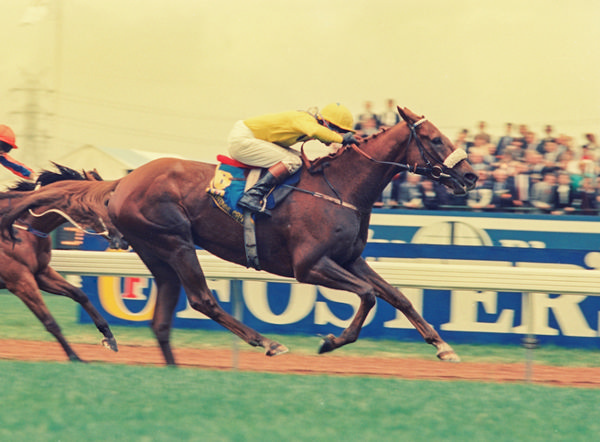
Following The Year Of Subbie the 1993 Cup was another wet one, and this time of epic proportions with the arrival of Vintage Crop (IRE)!
It was also a landmark turning point in Cup history.
On race morning it seemed highly doubtful the meeting could proceed.
At 7am the entirety of Flemington was ankle deep in water as rain continued to tumble from leaden skies.
The Melbourne Cup has only been postponed twice in its entire history - in 1870 and 1916.
But as a sodden and desolate little group of racing executives gathered at Flemington in the early hours of Cup morning, it looked like the unthinkable might have to happen.
The build up to this Cup had been enormous, as it was the very first to feature internationally trained horses. Public interest and debate was at fever pitch!
The first “raiders” were the legendary European stayer Drum Taps, who had to race muzzled because he liked to bite other horses - and former successful National Hunt horse Vintage Crop, patiently moulded into a top class flat performer by Ireland's champion trainer Dermot Weld.
These two had been the talk of the town for weeks - many pundits were of the view that their form would not translate to Aussie conditions, and would leave them with a great view of 22 bums going past the famous Flemington Clock Tower!
Others were adamant that these were animals possessed of inherent superiority over a distance.
This would just be the first taste of ongoing national humiliation, they warned darkly.
At Flemington on that fateful Cup morning many of the horse stalls were underwater and the Members Carpark had disappeared, but the show must go on.
Only the diehards actually went to the track. The rest of the nation tuned in agog to watch the Irish-bred Vintage Crop swan through the mud - going past the Gai Waterhouse trained roughie Te Akau Nick in the straight to win going away by three lengths and post a historic victory that would change the great race forever.
At least they hadn't quinella-ed it.
Drum Taps could do no better than ninth. Te Akau Nick and Gai were feted as heroic defenders of the nation's pride!
Vintage Crop would race in the next two Melbourne Cups under big weights, running seventh behind Jeune and third to Doriemus in1995 in another mud splattered Cup, the gallant Irish gelding's last race.
Vintage Crop lived out his days at the Irish National stud where the public loved to visit him. He died in 2014 at the age of 27.
Weld has become an integral part of Cup history, winning another particularly famous Cup with Media Puzzle in 2002 on a lightning fast track - with stablemate and race favourite Vinnie Roe under 59kg in fourth.
Vinnie was back two years later and got his preferred wet ground - with 58kg on his back he needed it. The great son of Definite Article would have won in an average year, as he went strongly to the lead a furlong out. But he was overtaken by a mare called Makybe Diva who came up the rail to beat him - and win her historic second Cup at a soggy Flemington.

